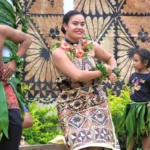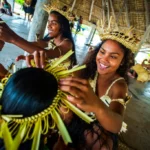Traditional Dress in Vanuatu: A Vibrant Expression of Heritage
Vanuatu, an archipelago in the South Pacific, boasts a rich tapestry of cultures and traditions, reflected in its diverse traditional clothing. Though modern influences have altered daily attire, traditional garments remain a vital part of ceremonies and cultural identity.
This article explores the history, styles, and cultural significance of Vanuatu’s traditional clothing, offering insight into the vibrant heritage of this unique nation.
Historical Roots of Vanuatu’s Traditional Clothing
Traditional clothing in Vanuatu has historically been shaped by the island’s tropical climate, natural resources, and cultural diversity. Early garments were crafted from locally available materials such as pandanus leaves, bark cloth, and natural fibers. These materials were woven, dyed, and adorned to create practical yet decorative attire.
Garments often symbolized social status, clan affiliations, and cultural identity. The intricate craftsmanship and vibrant colors reflect the artistry and creativity of the island’s indigenous communities.
See also Traditional clothing in Tonga
Traditional clothing in Tonga
Key Elements of Traditional Attire
👔 Men’s Clothing
- Nambas: The most iconic male garment in Vanuatu is the nambas, a traditional loincloth made from banana or pandanus leaves. The size and style of the nambas can vary between islands, with some using vibrant natural dyes for decoration.
- Headgear: Men often wear headbands or decorative headdresses adorned with feathers or shells during ceremonies.
- Accessories: Shell necklaces and armlets are common, symbolizing status or achievements.
👗 Women’s Clothing
- Grass Skirts: Women traditionally wear skirts made from finely woven pandanus or banana leaves. These skirts are often dyed in vibrant colors and layered for a dramatic effect.
- Upper Body Adornments: Women sometimes wear decorative necklaces or wraps during special occasions, highlighting their connection to cultural traditions.
🌺 Shared Adornments
- Shell and Bone Jewelry: Both men and women frequently wear jewelry made from shells, bones, or carved wood, showcasing Vanuatu’s connection to the sea.
- Face and Body Paint: Natural pigments are used for intricate designs during ceremonies, adding an expressive element to traditional attire.
Regional Variations
The diversity of Vanuatu’s islands is mirrored in the regional differences in traditional clothing:
- Northern Islands: Brightly colored nambas and skirts are popular, often paired with elaborate headdresses.
- Central Islands: More subdued tones and simpler designs emphasize connection to nature.
- Southern Islands: Unique patterns and extensive use of shell jewelry distinguish traditional attire.
Traditional Clothing in Cultural Ceremonies
Traditional clothing remains a central feature in Vanuatu’s ceremonies and celebrations:
- Matrilineal Rites: Ceremonial clothing is used to honor familial ties and ancestral heritage.
- Dances and Festivals: Events like the Nagol (land diving) include performers dressed in traditional attire, connecting the present to ancient practices.
- Spiritual Rituals: Garments and adornments are used to signify roles within rituals, enhancing the spiritual ambiance.
Modern Influence and Preservation Efforts
While modern clothing dominates daily life in Vanuatu, efforts to preserve traditional garments are evident:
- Cultural Education: Workshops teach weaving, dyeing, and crafting techniques to younger generations, ensuring the continuation of traditional skills.
- Festivals and Tourism: Events like the annual Fest’Napuan showcase traditional attire, fostering appreciation both locally and internationally.
- Community Initiatives: Local leaders encourage the integration of traditional garments into modern cultural expressions, blending old and new.
The Enduring Legacy of Traditional Clothing
Traditional clothing in Vanuatu serves as a vibrant reminder of the nation’s cultural richness and resilience. By celebrating and preserving these garments, Vanuatu’s people honor their ancestors and ensure that their unique heritage remains alive for future generations.
See also Traditional clothing in Kiribati
Traditional clothing in Kiribati
Whether through the striking simplicity of the nambas or the vibrant artistry of grass skirts, Vanuatu’s traditional clothing is a powerful expression of identity, creativity, and pride.